6 best ChatGPT detectors – free and paid options
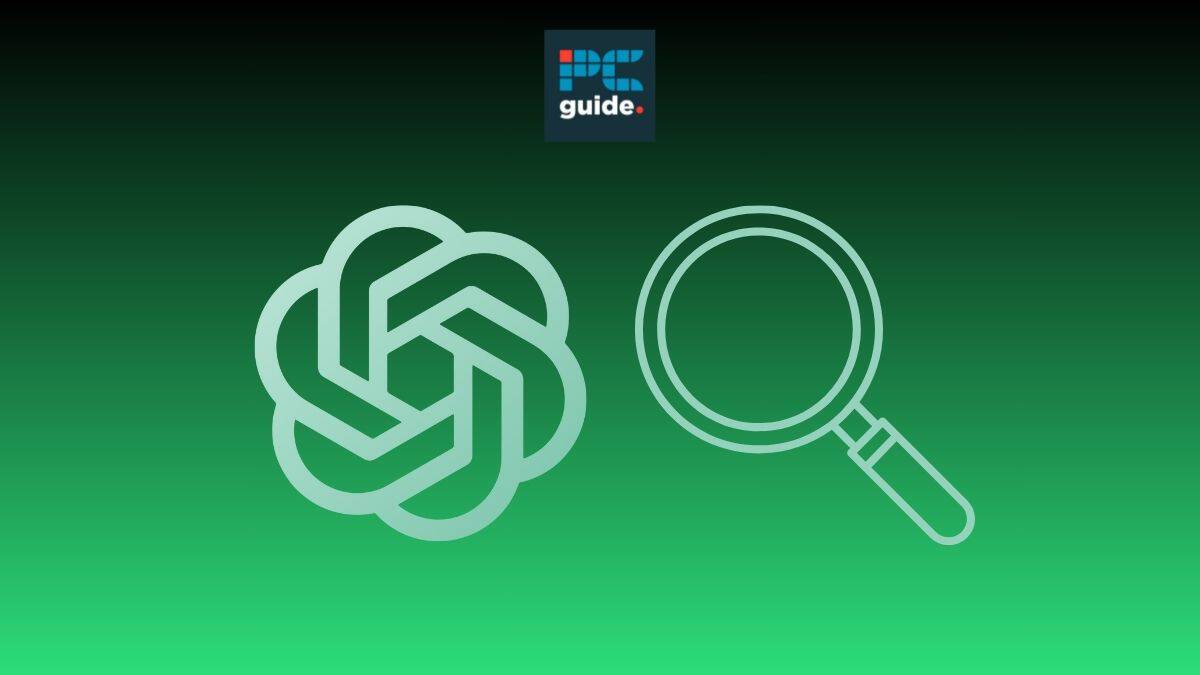
Table of Contents
Generative AI is an incredible content creation tool — until you get detected. If you’re a frequent user of OpenAI’s language model, you may be wondering what ChatGPT detector tools are out there. Synonymously known as AI detectors or AI checkers, this is software that can recognize when text has been written by AI. But how accurate can it be? How do you circumvent it? Should you consider doing your own work? In this article, we will dive into some of the best software that can detect ChatGPT, looking at the features of each platform in hopes of finding the right AI detector for you.
ContentGuardian.AI could be the right AI detector for you
There are a number of useful ChatGPT detectors out there that can identify the use of AI and plagiarism in written work. Our top picks include Originality.AI, ContentGuardian.AI, GPTZero, Content at Scale, GPTRadar, and CopyLeaks. ContentGuardian.AI harnesses the power from multiple other AI-detection platorms to ensure an accurate result. This is why it takes a top spot in our list.
6 best ChatGPT detectors
The best ChatGPT detector will be the most consistent at providing an accurate verdict. We’ve had a look at some of the detectors on the market at the minute and compiled a list of 6 platforms we think will do the job well.
Prime Day may have closed its doors, but that hasn't stopped great deals from landing on the web's biggest online retailer. Here are all the best last chance savings from this year's Prime event.
- Sapphire Pulse AMD Radeon™ RX 9070 XT Was $779 Now $719
- AMD Ryzen 7 7800X3D Processor Was $449 Now $341
- Skytech King 95 Ryzen 7 9800X3D gaming PC Was $2,899 Now $2,599
- LG 77-Inch Class OLED C5 TV Was $3,696 Now $2,996
- AOC Laptop Computer 16GB RAM 512GB SSD Was $360.99 Now $306.84
- Lexar 2TB NM1090 w/HeatSink SSD Was $281.97 Now $214.98
- Apple Watch Series 10 GPS+ Smartwatch Was $499.99 Now $379.99
- AMD Ryzen 9 5950X processor Was $3199.99 Now $279.99
- Garmin vívoactive 5 Smartwatch Was $299.99 Now $190
*Prices and savings subject to change. Click through to get the current prices.
ChatGPT detectors compared
| Name | No. of Checker engines | AI checking | Plagiarism checking | Grammar checking | Chrome extension | API integration | Free plan/trial |
|---|---|---|---|---|---|---|---|
| Originality.ai | 1 | Yes | Yes | No | Yes | Yes | Yes |
| ContentGuardian.ai | 8 | Yes | On roadmap | No | On roadmap | On roadmap | Yes |
| GPTZero | 1 | Yes | Yes | No | Yes | Yes | Yes |
| Content at Scale | 1 | Yes | No | No | No | No | Yes |
| GPTRadar | 1 | Yes | No | No | No | No | Yes |
| CopyLeaks | 1 | Yes | Yes | No | Yes | Yes | Yes |
6 best ChatGPT detectors
Originality.AI
Originality.AI is one of the most accurate detectors of AI-generated content on the market today and boasts an impressive accuracy of 96% over a testing data set of 1200 samples. It can detect anything from GPT-4 to Google Gemini, and more. This tool can easily identify human-written content, and can even highlight specific sections of content that it predicts will be AI-generated. Then it can report which text was AI-generated and which text was not. As a result, it helps educators to detect the use of AI to write essays and reports.
Orginality.AI is built more with web publishers in mind, rather than academia. Therefore, you can gain access to other features that help with content output and workflow with your team. Pricing is set at $0.01 per credit, with 1 credit scan equalling 100 words.
Due to platforms like this still being in the early stages of their existence, there are going to be apparent pros & cons. Some of the main benefits when using Originality.AI are its user-friendly interface, built-in plagiarism checker, affordable pricing, and API access. However, like many AI-related tools, there are going to be drawbacks. With Originality.AI, these drawbacks include it currently only supports the English Language, and users aren’t able to differentiate between content that is AI-generated and Plagiarized.
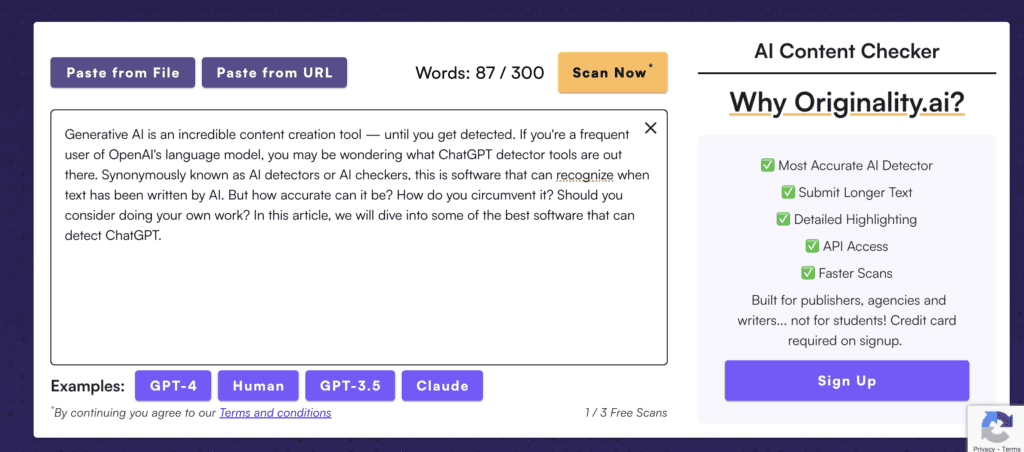
Content Guardian AI
Content Guardian AI takes a unique approach as it doesn’t have its own model but instead chooses to connect to the leading checkers and provides the user with a score for each. This provides convenience plus confidence for the user. They don’t need to put ‘all their eggs in one basket’ as not all checkers models keep up to speed with new iterations of LLMs.
Results can vary from checker to checker so Content Guardian AI has created their own score. They state in their article on the Content Guardian Score:
“Rather than developing a singular, standalone model, we've chosen to integrate multiple leading AI content detectors. This synergy allows us to harness the strengths of each platform, mitigating the weaknesses inherent in any single-model approach”
Content Guardian
The platform aims to take all the strengths and weaknesses of the checkers to provide an overall score, which they call the Content Guardian Score. With new LLM models (and versions) popping up seemingly weekly this is an innovative solution for the user to have a consistent scoring mechanism that they can rely on. For the users that publish using WordPress Content Guardian has developed a Plugin that integrates directly into your existing workflow. A nice addition and the tool is certainly targeting content creators that have websites.
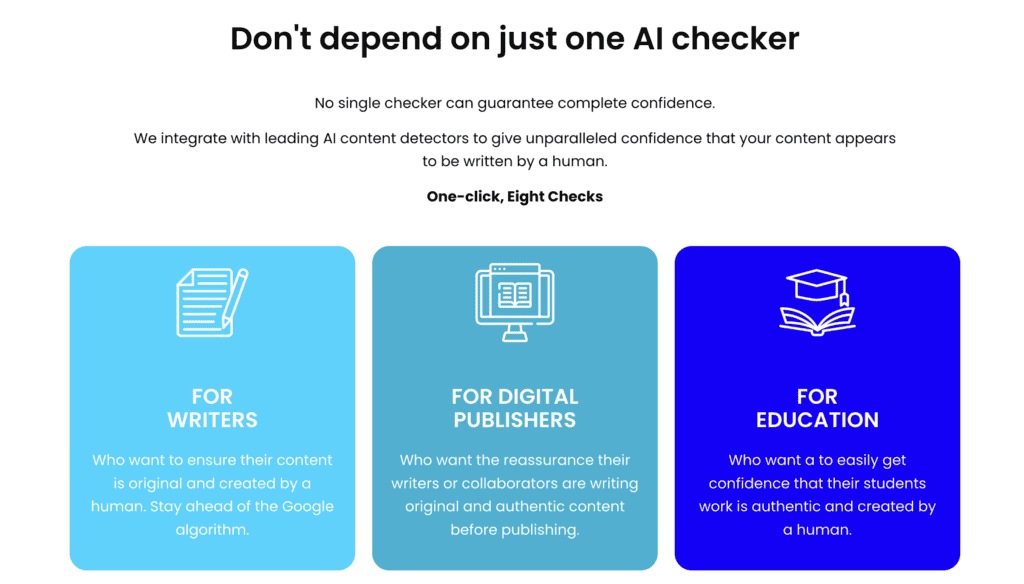
Essential AI Tools
GPTZero
Edward Tian, a 22-year-old from Princeton University, developed a tool called GPTZero. The app claims to detect texts created by ChatGPT and as of late has had a 98% success rate. The pilot version of GPTZero is currently available for free on their website. The tools work by measuring two attributes of the generated text: Perplexity and burstiness. The higher the perplexity or the more random the text is, the higher the chance a human wrote it. In addition, burstiness relates to how intricate the sentences are. According to Tian, humans typically write using varied sentence lengths to create impact. Whereas, AI models tend to write more consistently. By looking at both perplexity and burstiness, Tian has managed to create a very reliable ChatGPT detector.
GPTZero also offers plagiarism detection as part of its use. So it’s not purely looking for instances of natural language processing-generated content. It’s also checking to offer a holistic score on the originalist of the content. They also have an API, so you can integrate GPTZero's AI detection abilities into your own tools.
We decided to try out the tool for ourselves. In the images below you can see how GPTZero responds with accuracy when detecting an extract generated by ChatGPT.
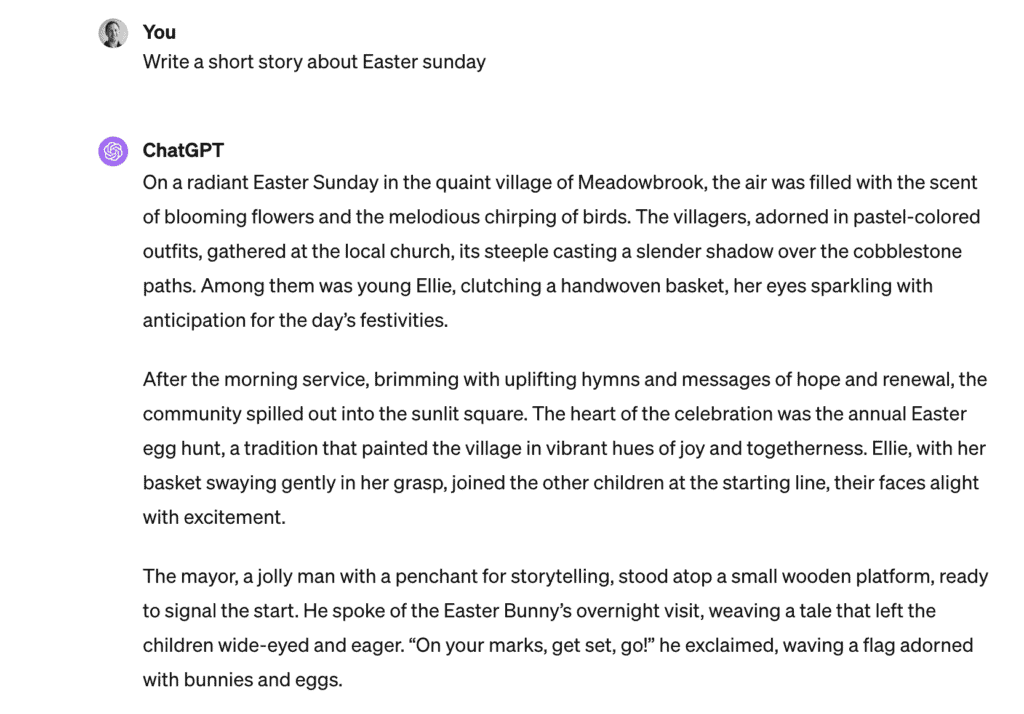
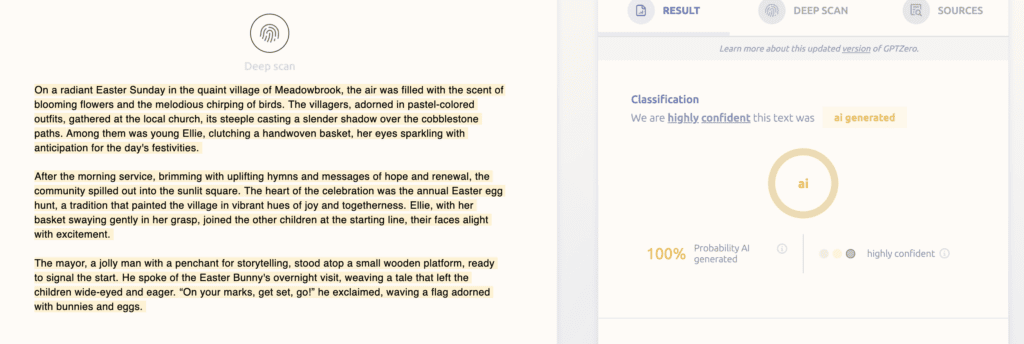
The pros of GPTZero include how it can help users improve their writing skills by comparing their text with AI-generated content and providing differences, and it has a completely free-to-use version. On the other hand, the cons of this platform include it might not be able to detect all forms of AI content especially if mixed with human-written work, and it may have false positives or negatives.
Content at Scale AI detector
Content at Scale is an AI detection tool that is trained on billions of individual pages of data from a number of large language models. It then uses this data to check whether the inputted content is AI-generated or human-written. Their artificial intelligence AI classifier boasts 98% accuracy across ChatGPT, GPT 4, Google Bard, Microsoft Bing Chat, and Anthropic Claude. Content at Scale also offers an AI writing tool for producing undetectable AI content, backed by their own AI checker software – in other words, if they can’t detect AI-written text, then no one can! At least, that’s the pitch:
Our proprietary content platform uses a mix of 3 AI engines, natural language processing (NLP) and semantic analysis algorithms, crawls Google, and parses all the top ranking content to put research-backed, long-form, SEO driven blog posts together.
Cotent at Scale webpage
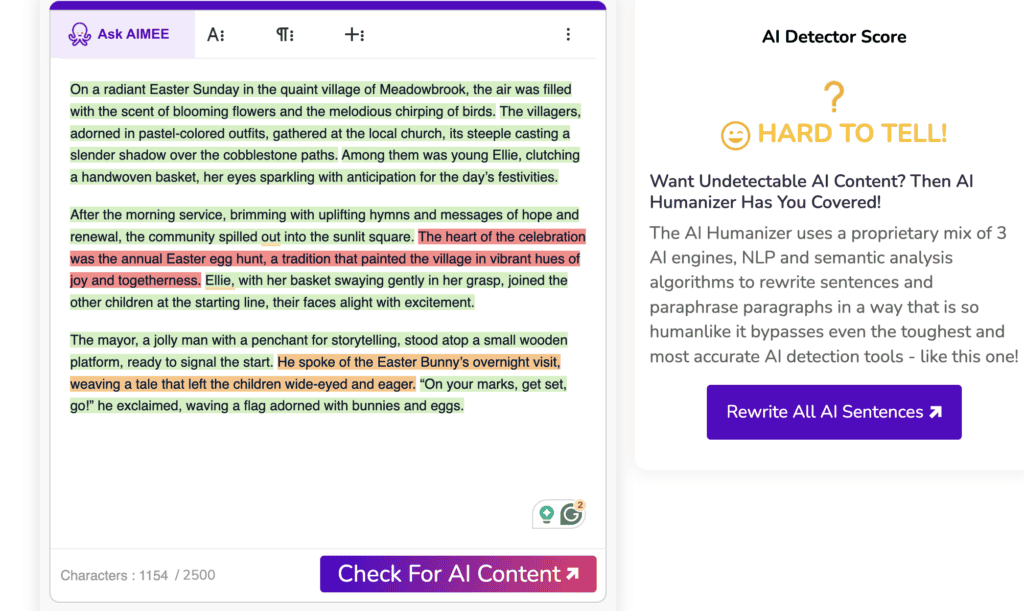
As seen in the image above, the platform struggled to detect that the extract was fully written by AI, unlike GPTZero which was tested with the same extract. So what are the other downsides of this platform? Well firstly, the tool has no plagiarism checker, unlike lots of similar platforms on the market. Additionally, it has no URL scanning. However, some of the apparent benefits of this tool include its very easy to use, it has a fast scanning speed, and there’s no sign-up required.
GPTRadar
GPTRadar is another ChatGPT and AI detector created by Alessio Nittoli and Antonio Cappiello. It uses OpenAI’s GPT-3 to figure out if the content is written by a human or generated by a machine. You can use the tool for free to start without signing up, but then you’ll have to buy credits to detect and edit more text.
GPTRadar works by placing an inputted text in either a “Likely AI-generated” or “Likely Human-generated” category and provides a detailed analysis as to why it has come to this conclusion. GPTRadar uses Token probability as one of its deciding factors, it provides a 3D graph of token probability distribution and a version of the text where potential AI-generated phrases or highlighted.
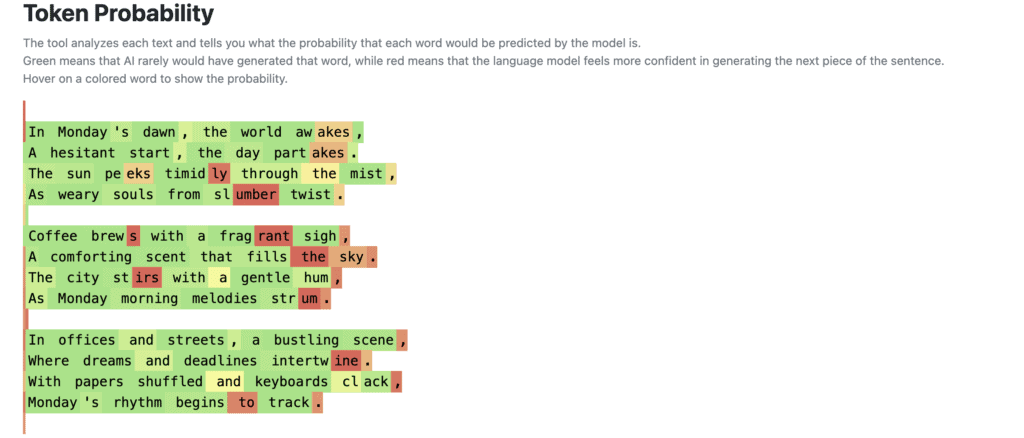
Similarly to other AI detectors mentioned in this list, there are apparent drawbacks and benefits to this platform. The drawbacks of GPTRadar include, the scoring system could be confusing for those unfamiliar with tokens, it doesn’t remain free forever, and it has limited accuracy when compared to other tools on this list. The benefits of this product include providing reasons for its scoring, highlighting specific areas in the text, and providing a perplexity score.
CopyLeaks
CopyLeaks is a well-polished addition to this list, offering both AI and plagiarism detection in one convenient package. Unlike most other options, you can use it as a Chrome extension or via an API, giving you a superior level of flexibility. It also offers multiple models to choose from when running your detection. Based on a 4-star rating averaging over 240+ reviews, CopyLeaks is a solid choice for the detection of AI-generated content.
CopyLeaks is a free or paid version of the platform. The free version is perfect for checking shorter extracts of text quickly, however, if you need a tool that checks larger documents more often then we’d recommend signing up for the paid version.
A definite pro of this platform is the ease of the API, which is a unique quality when looking at AI detectors. Additionally, the support and help from this platform are always fast, and you can get individual pricing plans for each individual user’s needs. However, a drawback of this platform is that it has the ability to save your work to the CopyLeaks database, which might not be ideal for all users.
What is the best detector for ChatGPT?
Of all individual ChatGPT detection tools, Originality AI is a strong option. However, false positives are always possible with ChatGPT detectors; to minimize the possibility of encountering them, you may be best to run checks across two or more detectors, which is why the use of Content Guardian AI may be the right choice for you. Also, if you are paying for one, GPTZero is a good supplementary detector tool to use as it’s free. Similarly, ZeroGPT, which is a separate tool, is worth using for any piece of writing or piece of content you want to check.
Verdict
OpenAI’s ChatGPT has been the most popular generative AI since its release on November 30th, 2022. As an AI chatbot, it takes a simple text prompt and outputs a response, also text-based. Despite the simple nature of this exchange, the potential use cases have grown exponentially in scope since it can check grammar and punctuation or write new text you won’t find on the internet. Now that ChatGPT can access the internet, it can even provide citations of where it drew that information from — information that didn’t exist in its own training data.
Many users have been taking advantage of what this model can do. For example, using the bot for essay writing, completing coding tasks, and generating creative content. In the education industry, anti-cheating software companies and AI detection businesses are playing a game of cat and mouse trying to catch up with ChatGPT’s capabilities. Thus we have an arms race between AI generators and AI detectors. What makes this battle even more futile (and admittedly funny) is the fact that it's equally easy for a student to check ‘their work' with an AI detector to ensure it's undetectable, as it is for the educator trying to catch them.
OpenAI, Google, and other AI firms have pledged to watermark AI-generated content for safety. This will ultimately make AI tools and their outputs far easier to detect, with more consistency than existing content detection tools.

